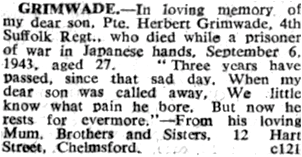Herbert George Grimwade was born and raised in Chelmsford and prior to joining the army worked in the building trade. His uncle won the British Empire Medal for his part in rescuing victims of the Coval Lane bombing in 1941. Later that year Herbert went overseas to the Far East. He was captured by the Japanese at Singapore in February 1942. Forced to work on the notorious Siam-Burma ‘death railway’ he died as prisoner of war in September 1943.
Herbert was born in Chelmsford in 1916, the eldest son of George John Grimwade (1880-1943) and Olive Ellen Grimwade (nee Collins) (1891-1964). His parents had married at St. Mary’s Church, Chelmsford (today’s Cathedral) on 5th April 1913. At the time Herbert’s father was aged 29, and a labourer. His bride was seven years his junior. Both lived at 2 Glebe Road in Chelmsford.
Herbert was baptised, along with his brother Douglas Arthur, at St. Mary’s Church on 1st December 1918. At the time his father was a labourer, living at 39 New Writtle Street in Chelmsford.
Herbert's siblings included Gladys Olive Grimwade (1914-2002), Douglas Arthur Grimwade (born in 1918), Stanley William Grimwade (1919-1990), Doris M Grimwade (born 1921), Phyllis Edith Grimwade (1924-1999), George John Grimwade (1926-1981), Arthur Grimwade (1928-2000), Edna Alice Grimwade (1931-1993), Marjorie Grimwade (1933-1995), and Maurice Grimwade (born 1937).
Prior to the Second World War Herbert worked in the building trade. During the war he served as Private 6020746 in the 4th Battalion of the Suffolk Regiment.
His uncle, James Ellis Grimwade, was awarded the British Empire Medal, for bravely and skill helping to rescue four victims when properties in Marconi Road, Chelmsford were bombed on 9th May 1941, despite the grave dangers posed by the partially demolished buildings around him.
Herbert's battalion was sent overseas by ship late in 1941, arriving in Halifax, Nova Scotia, then on to Trinidad before reaching Cape Town, South Africa in December 1941. At that point it seemed to many in the battalion that it was heading for Egypt. However, by the end of the month the battalion was in Bombay, India and on 19th January 1942 it left for Singapore which was threatened by invasion by the Japanese. Herbert and the rest of his battalion arrived in Singapore on 29th January 1942. Six days later it suffered its first casualties in combat. The Japanese advance continued and on 15th February 1942 Herbert along with the rest of the battalion were captured by the Japanese following the surrender of the Commonwealth forces.
In July 1943 Herbert’s family finally received a letter confirming that he was a prisoner of war.
Five months later Herbert’s father died, aged 63.
Herbert George GRIMWADE, Private, 4th Battalion, Suffolk Regiment
Killed while a prisoner of war in Japanese hands in Thailand. Aged 27
Many of the men in the 4th Battalion of the Suffolk Regiment suffered appallingly through a combination of brutality, disease and starvation. Herbert died whilst a prisoner of war in Japanese hands on 6th September 1943 in Burma. He was 27 years old and was one of more than 250 men from the battalion to die whilst prisoners of war, many while working as forced labourers on the notorious Siam to Burma 'Death Railway'.
The railway, built by Commonwealth, Dutch and American prisoners of war, was a Japanese project driven by the need for improved communications to support the large Japanese army in Burma. During its construction, approximately 13,000 prisoners of war died and were buried along the railway. An estimated 80,000 to 100,000 civilians also died in the course of the project, chiefly forced labour brought from Malaya and the Dutch East Indies, or conscripted in Siam (Thailand) and Burma (Myanmar). Two labour forces, one based in Siam and the other in Burma worked from opposite ends of the line towards the centre. The Japanese aimed at completing the railway in 14 months and work began in October 1942. The line, 424 kilometres long, was completed by December 1943.
Where found, the graves of those who died during the construction and maintenance of the railway (except for the Americans, whose remains were repatriated) were transferred from camp burial grounds and isolated sites along the railway into three cemeteries at Chungkai and Kanchanaburi in Siam (now Thailand) and Thanbyuzayat in Burma (now Myanmar).
Today Herbert lies in grave B1. D. 5. at Thanbyuzayat War Cemetery. He left an estate valued at £107 6s. 2d.
Herbert's mother lived at 12 Hart Street in Chelmsford. She did not receive news of Herbert's death until late 1945.
Herbert was a cousin of Frederick William Grimwade. His uncle, Herbert William Grimwade won the Military Medal during the First World War.
160207


